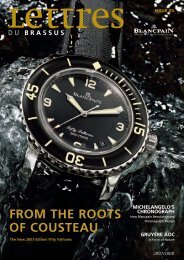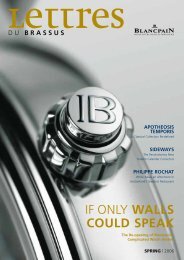THE HISTORY OF BLANCPAIN
THE HISTORY OF BLANCPAIN
THE HISTORY OF BLANCPAIN
You also want an ePaper? Increase the reach of your titles
YUMPU automatically turns print PDFs into web optimized ePapers that Google loves.
Tous nos droits sur ce document sont réservés. Ce dernier<br />
est destiné au seul destinataire autorisée. Sans notre<br />
autorisation écrite préalable, il ne peut être ni copié,<br />
ni reproduit, ni communiqué à des tiers.<br />
IN TIME<br />
Again trial and error was the order of<br />
the day to determine final shape. Too<br />
much top surface rounding would produce<br />
great visual allure, but had the<br />
unfortunate side effect of distorting the<br />
markings underneath. Too little rounding<br />
treatment and visual interest diminished.<br />
After dozens and dozens of experiments,<br />
Blancpain arrived at the happy medium, a<br />
non-distorting subtle curvature which<br />
enhanced both the exterior shape of the<br />
watch and the markings underneath.<br />
The development work was still far<br />
from completed. Next, Blancpain under-<br />
The ensemble of bezel and crystal create the ambiance of the<br />
historic Fifty Fathoms, but carried out in modern materials.<br />
Cotes en mm<br />
Tolérances en μ<br />
Tol. générales: ±20 Angles non tol.: ±5°<br />
took the search for a suitable adhesive to<br />
secure the sapphire ring into a metal channel<br />
which would house it. Because the Fifty<br />
Fathoms featured a rotating bezel (a diving<br />
must), it would have a grip surface on its<br />
outside circumference to facilitate turning.<br />
Both strength and suppleness were identified<br />
as requirements for the adhesive. Suppleness<br />
was particularly vital as the adhesive would<br />
need to compensate for temperature changes<br />
and the expansion and contraction of the<br />
metal channel.<br />
Of course the sapphire bezel did not exist<br />
in visual isolation. It truly was part of a visu-<br />
al ensemble with the crystal itself. The original<br />
Fifty Fathoms featured a mineral glass<br />
crystal which was both thick and rounded<br />
to withstand water pressure during dives. It<br />
was out of the question to turn the clock<br />
backwards and fashion the crystal for the<br />
new watch out of scratch prone mineral<br />
glass. However, it was clear that the original<br />
look had to be respected. Thus the<br />
new sapphire crystal would feature a<br />
rounded top surface and a slight shoulder<br />
which captured the muscular ambiance of<br />
the 1953 original. But the crystal, although<br />
rounded, was not to function as a lens, so







